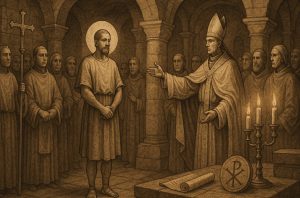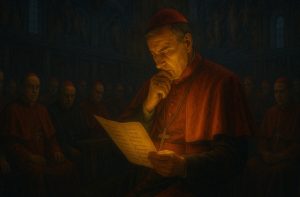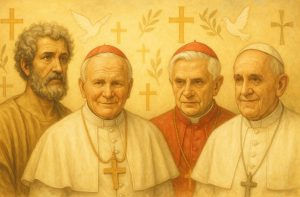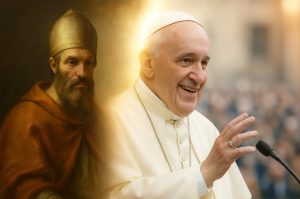Since the 6th century, popes have adopted new names upon election, a symbolic act reflecting spiritual transformation, humility, and leadership intent. But why do popes change their names? The answer lies in a blend of history, tradition, and personal conviction that continues to shape the papacy today.
What Is the History Behind Papal Name Changes?

The tradition of papal name changes traces its roots back to the Bible, where Simon was renamed Peter by Jesus a precedent seen as the spiritual foundation for the practice.
However, the formal adoption of a new name by popes began in 533 AD with Mercurius.
Concerned that his pagan-associated name was inappropriate for the leader of the Christian world, he chose to be called Pope John II, aligning himself with a respected and martyred predecessor.
Although early popes generally retained their birth names, the adoption of new names gained traction over time.
Catholic scholar Jimmy Akin notes in Pope Names that only a few popes in the first millennium changed their names and all chose “John.” The real shift occurred in 996, when Bruno of Carinthia became Gregory V, establishing a tradition that has endured ever since.
What Do Papal Names Symbolise and Mean?
Papal names are more than titles they’re declarations of intent. New popes often select names that honour saints, Biblical figures, or previous popes whose legacies they admire or hope to continue.
This symbolism reflects the new pope’s theological focus, personality, or aspirations for their papacy.
For example:
- Pope Francis chose his name in homage to St. Francis of Assisi, emphasising humility, care for the poor, and environmental stewardship.
- Benedict XVI drew inspiration from St. Benedict of Nursia, the founder of Western monasticism, and from Pope Benedict XV, known for peace advocacy during World War I.
- John Paul I was the first to combine two papal names, signalling unity and continuity with his predecessors, John XXIII and Paul VI.
According to historian Liam Temple, linking a new pope to predecessors who led during crisis or reform can reassure the faithful and convey a sense of stability.
How Do New Popes Choose Their Names?

While there are no formal rules governing the choice of papal names, the decision is steeped in tradition and ritual. According to the Universi Dominici Gregis, the rules governing papal elections, the newly elected pope is immediately asked:
“Do you accept your canonical election as Supreme Pontiff?”
If he consents, the next question is:
“By what name do you wish to be called?”
This question marks the first public act of the pope-elect’s reign. Though popes can technically retain their birth names or adapt them, most choose a completely new regnal name.
As Anura Guruge notes in Popes and the Tale of Their Names, the choice is entirely personal and often inspired by spiritual reflection and historical significance.
Which Papal Names Have Been Notable Throughout History?
Some papal names have made a lasting impression due to their originality, symbolism, or the legacies of those who bore them:
- John Paul I (1978): The first pope to combine names and declare himself “the first,” he honoured John XXIII and Paul VI, signalling continuity. His reign lasted only 33 days.
- John Paul II (1978–2005): Adopted the same name to honour his predecessor and continue his vision.
- Pius XII (1939–1958): His name pointed to a continuation of the approach of Pius XI.
- Francis (2013–present): Marked the first new papal name since 918, symbolising a break from recent tradition and a renewed focus on humility and social justice.
According to uCatholic.com, Francis is one of 44 papal names used only once. In contrast, John is the most frequently chosen, used by 21 popes, followed by Gregory (16), Benedict (15), Clement (14), and Innocent and Leo (13 each).
Why Are Papal Names Theologically and Culturally Significant?

Choosing a new name is deeply theological, echoing scriptural moments where individuals received new names from God to mark divine missions (e.g., Abram to Abraham, Saul to Paul). The practice symbolises rebirth and a complete commitment to a new spiritual role.
Culturally, papal names influence how both Catholics and the global community perceive the Church. A name like Francis suggests a humble, people-focused papacy, while Benedict may imply a more doctrinal and traditional leadership style.
How Do Papal Names Influence Public Expectations?
A pope’s name instantly sets the tone for their leadership and is often the first indicator of their priorities. The faithful, theologians, and media all look to the chosen name to glean insight into the papacy’s potential direction.
As Joshua McManaway, a Church history expert, explains:
“There are very few rules for the man at the top, so they’re allowed to choose what they want… But no pope chooses the name ‘Peter’ out of respect for St. Peter the Apostle. That may be a bridge too far!”
Indeed, names not only reflect humility but also avoid unwarranted comparisons with foundational figures like St. Peter.
What Are the Most Recent Papal Name Changes?
Here’s a table summarising modern papal name choices and their meanings:
| Pope Name | Original Name | Year Elected | Reason for Name |
| Francis | Jorge Mario Bergoglio | 2013 | In honour of St. Francis of Assisi |
| Benedict XVI | Joseph Ratzinger | 2005 | Inspired by St. Benedict and Pope Benedict XV |
| John Paul II | Karol Józef Wojtyła | 1978 | Tribute to John Paul I and continuity |
| John Paul I | Albino Luciani | 1978 | Combined names of predecessors John XXIII & Paul VI |
These name choices offered both homage and vision, guiding their papacies and shaping global perceptions.
Is the Tradition of Changing Papal Names Still Relevant?

While some might question the relevance of this tradition in the modern age, it remains a deeply meaningful practice.
Changing one’s name symbolises a transformation and acceptance of a higher calling, echoing centuries of religious tradition.
It also serves as a spiritual and public declaration of how a new pope intends to lead, making the tradition not only relevant but essential.
What Does a Papal Name Reveal About Identity and Legacy?
A pope’s chosen name becomes a defining feature of their legacy. It offers the first and lasting insight into their priorities, theology, and leadership style.
From John to Francis, the evolution of papal names reflects the Catholic Church’s continuous journey through history, culture, and faith.
Frequently Asked Questions
What is the first recorded instance of a pope changing his name?
The earliest example is Pope John II in 533 AD, who changed his name from Mercurius to avoid pagan connotations.
Do popes choose their names alone or with guidance?
The choice is personal, though many popes reflect on Church history, saints, and spiritual mentors for inspiration.
Is there a list of forbidden papal names?
No names are officially banned, but “Peter” is traditionally avoided out of respect for St. Peter, the first pope.
Can a pope keep his birth name?
Yes, but it’s extremely rare. The last pope to do so was Marcellus II in 1555, who served for just 22 days.
What happens after a pope announces his new name?
The name is declared to the public during the Habemus Papam announcement and marks the beginning of his papacy.
Are papal garments influenced by chosen names?
No, garments like the white cassock symbolise purity and authority, not the chosen name.
How do papal names reflect the Church’s direction?
They often signal theological priorities, peace, reform, tradition, humility guiding the pope’s leadership approach.






